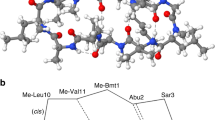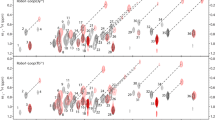Abstract
Analogous to the recently introduced ARTSY method for measurement of one-bond 1H–15N residual dipolar couplings (RDCs) in large perdeuterated proteins, we introduce methods for measurement of base 13C–1H and 15N–1H RDCs in protonated nucleic acids. Measurements are based on quantitative analysis of intensities in 1H–15N and 13C–1H TROSY-HSQC spectra, and are illustrated for a 71-nucleotide adenine riboswitch. Results compare favorably with those of conventional frequency-based measurements in terms of completeness and convenience of use. The ARTSY method derives the size of the coupling from the ratio of intensities observed in two TROSY-HSQC spectra recorded with different dephasing delays, thereby minimizing potential resonance overlap problems. Precision of the RDC measurements is limited by the signal-to-noise ratio, S/N, achievable in the 2D TROSY-HSQC reference spectrum, and is approximately given by 30/(S/N) Hz for 15N–1H and 65/(S/N) Hz for 13C–1H. The signal-to-noise ratio of both 1H–15N and 1H–13C spectra greatly benefits when water magnetization during the experiments is not perturbed, such that rapid magnetization transfer from bulk water to the nucleic acid, mediated by rapid amino and hydroxyl hydrogen exchange coupled with 1H–1H NOE transfer, allows for fast repetition of the experiment. RDCs in the mutated helix 1 of the riboswitch are compatible with nucleotide-specifically modeled, idealized A-form geometry and a static orientation relative to the helix 2/3 pair, which differs by ca 6° relative to the X-ray structure of the native riboswitch.













Similar content being viewed by others
References
Andersson P, Annila A, Otting G (1998) An alpha/beta-HSQC-alpha/beta experiment for spin-state selective editing of IS cross peaks. J Magn Reson 133:364–367
Bax A, Grishaev A (2005) Weak alignment NMR: a hawk-eyed view of biomolecular structure. Curr Opin Struct Biol 15:563–570
Bax A, Griffey RH, Hawkins BL (1983) Correlation of proton and nitrogen-15 chemical shifts by multiple quantum NMR. J Magn Reson 55:301–315
Bhattacharya A, Revington M, Zuiderweg ERP (2010) Measurement and interpretation of N-15-H-1 residual dipolar couplings in larger proteins. J Magn Reson 203:11–28
Boisbouvier J, Brutscher B, Simorre JP, Marion D (1999) C-13 spin relaxation measurements in RNA: Sensitivity and resolution improvement using spin-state selective correlation experiments. J Biomol NMR 14:241–252
Boisbouvier J, Delaglio F, Bax A (2003) Direct observation of dipolar couplings between distant protons in weakly aligned nucleic acids. Proc Natl Acad Sci USA 100:11333–11338
Bouvignies G, Bernado P, Meier S, Cho K, Grzesiek S, Bruschweiler R, Blackledge M (2005) Identification of slow correlated motions in proteins using residual dipolar and hydrogen-bond scalar couplings. Proc Natl Acad Sci USA 102:13885–13890
Cho CH, Urquidi J, Singh S, Robinson GW (1999) Thermal offset viscosities of liquid H2O, D2O, and T2O. J Phys Chem B 103:1991–1994
Clore GM (2000) Accurate and rapid docking of protein–protein complexes on the basis of intermolecular nuclear Overhauser enhancement data and dipolar couplings by rigid body minimization. Proc Natl Acad Sci USA 97:9021–9025
de Alba E, Tjandra N (2006a) Interference between cross-correlated relaxation and the measurement of scalar and dipolar couplings by quantitative J. J Biomol NMR 35:1–16
de Alba E, Tjandra N (2006b) On the accurate measurement of amide one-bond N-15-H-1 couplings in proteins: Effects of cross-correlated relaxation, selective pulses and dynamic frequency shifts. J Magn Reson 183:160–165
Delaglio F, Grzesiek S, Vuister GW, Zhu G, Pfeifer J, Bax A (1995) NMRpipe—a multidimensional spectral processing system based on Unix pipes. J Biomol NMR 6:277–293
Evenas J, Mittermaier A, Yang DW, Kay LE (2001) Measurement of C-13(alpha)-C-13(beta) dipolar couplings in N- 15, C-13, H-2-labeled proteins: Application to domain orientation in maltose binding protein. J Am Chem Soc 123:2858–2864
Farjon J, Boisbouvier J, Schanda P, Pardi A, Simorre JP, Brutscher B (2009) Longitudinal-Relaxation-Enhanced NMR Experiments for the Study of Nucleic Acids in Solution. J Am Chem Soc 131:8571–8577
Fitzkee NC, Bax A (2010) Facile measurement of H-1-N-15 residual dipolar couplings in larger perdeuterated proteins. J Biomol NMR 48:65–70
Freeman R, Kempsell SP, Levitt MH (1980) Radiofrequency pulse sequences which compensate their own imperfections. J Magn Reson 38:453–479
Geen H, Freeman R (1991) Band-selective radiofrequency pulses. J Magn Reson 93:93–141
Grishaev A, Ying J, Canny MD, Pardi A, Bax A (2008) Solution structure of tRNA(Val) from refinement of homology model against residual dipolar coupling and SAXS data. J Biomol NMR 42:99–109
Grishaev A, Yao LS, Ying JF, Pardi A, Bax A (2009) Chemical Shift Anisotropy of Imino N-15 Nuclei in Watson-Crick Base Pairs from Magic Angle Spinning Liquid Crystal NMR and Nuclear Spin Relaxation. J Am Chem Soc 131:9490–9492
Hansen DF, Vallurupalli P, Kay LE (2008a) Quantifying two-bond (HN)-H-1-(CO)-C-13 and one-bond H-1(alpha)-C-13(alpha) dipolar couplings of invisible protein states by spin-state selective relaxation dispersion NMR spectroscopy. J Am Chem Soc 130:8397–8405
Hansen DF, Vallurupalli P, Kay LE (2008b) Using relaxation dispersion NMR spectroscopy to determine structures of excited, invisible protein states. J Biomol NMR 41:113–120
Hwang TL, van Zijl PCM, Garwood M (1997) Broadband adiabatic refocusing without phase distortion. J Magn Reson 124:250–254
Kay LE, Keifer P, Saarinen T (1992) Pure absorption gradient enhanced heteronuclear single quantum correlation spectroscopy with improved sensitivity. J Am Chem Soc 114:10663–10665
Kontaxis G, Clore GM, Bax A (2000) Evaluation of cross-correlation effects and measurement of one- bond couplings in proteins with short transverse relaxation times. J Magn Reson 143:184–196
Kuszewski J, Schwieters C, Clore GM (2001) Improving the accuracy of NMR structures of DNA by means of a database potential of mean force describing base–base positional interactions. J Am Chem Soc 123:3903–3918
Lescop E, Schanda P, Brutscher B (2007) A set of BEST triple-resonance experiments for time-optimized protein resonance assignment. J Magn Reson 187:163–169
Levitt MH, Freeman R (1981) Compensation for pulse imperfections in NMR spin-echo experiments. J Magn Reson 43:65–80
Losonczi JA, Andrec M, Fischer MWF, Prestegard JH (1999) Order matrix analysis of residual dipolar couplings using singular value decomposition. J Magn Reson 138:334–342
Mantylahti S, Koskela O, Jiang P, Permi P (2010) MQ-HNCO-TROSY for the measurement of scalar and residual dipolar couplings in larger proteins: application to a 557-residue IgFLNa16–21. J Biomol NMR 47:183–194
Meissner A, Duus JO, Sorensen OW (1997) Spin-state-selective excitation. Application for E.COSY-type measurement of J(HH) coupling constants. J Magn Reson 128:92–97
Ottiger M, Delaglio F, Bax A (1998) Measurement of J and dipolar couplings from simplified two-dimensional NMR spectra. J Magn Reson 131:373–378
Palmer AG, Cavanagh J, Wright PE, Rance M (1991) Sensitivity improvement in proton-detected 2-dimensional heteronuclear correlation Nmr-spectroscopy. J Magn Reson 93:151–170
Permi P, Rosevear PR, Annila A (2000) A set of HNCO-based experiments for measurement of residual dipolar couplings in N-15, C-13, (H-2)-labeled proteins. J Biomol NMR 17:43–54
Pervushin K, Riek R, Wider G, Wuthrich K (1997) Attenuated T-2 relaxation by mutual cancellation of dipole- dipole coupling and chemical shift anisotropy indicates an avenue to NMR structures of very large biological macromolecules in solution. Proc Natl Acad Sci USA 94:12366–12371
Pervushin K, Riek R, Wider G, Wuthrich K (1998a) Transverse relaxation-optimized spectroscopy (TROSY) for NMR studies of aromatic spin systems in C-13-labeled proteins. J Am Chem Soc 120:6394–6400
Pervushin KV, Wider G, Wuthrich K (1998b) Single transition-to-single transition polarization transfer (ST2-PT) in [N15, H1]-TROSY. J Biomol NMR 12:345–348
Peti W, Meiler J, Bruschweiler R, Griesinger C (2002) Model-free analysis of protein backbone motion from residual dipolar couplings. J Am Chem Soc 124:5822–5833
Piotto M, Saudek V, Sklenár V (1992) Gradient-tailored excitation for single-quantum NMR spectroscopy of aqueous sloutions. J Biomol NMR 2:661–665
Prestegard JH, Al-Hashimi HM, Tolman JR (2000) NMR structures of biomolecules using field oriented media and residual dipolar couplings. Q Rev Biophys 33:371–424
Schanda P, Van Melckebeke H, Brutscher B (2006) Speeding up three-dimensional protein NMR experiments to a few minutes. J Am Chem Soc 128:9042–9043
Serganov A, Patel DJ (2007) Ribozymes, riboswitches and beyond: regulation of gene expression without proteins. Nat Rev Genet 8:776–790
Skrynnikov NR, Kay LE (2000) Assessment of molecular structure using frame-independent orientational restraints derived from residual dipolar couplings. J Biomol NMR 18:239–252
Skrynnikov NR, Goto NK, Yang DW, Choy WY, Tolman JR, Mueller GA, Kay LE (2000) Orienting domains in proteins using dipolar couplings measured by liquid-state NMR: Differences in solution and crystal forms of maltodextrin binding protein loaded with beta-cyclodextrin. J Mol Biol 295:1265–1273
Tjandra N, Bax A (1997a) Direct measurement of distances and angles in biomolecules by NMR in a dilute liquid crystalline medium. Science 278:1111–1114
Tjandra N, Bax A (1997b) Measurement of dipolar contributions to (1)J(CH) splittings from magnetic-field dependence of J modulation in two-dimensional NMR spectra. J Magn Reson 124:512–515
Tolbert BS, Miyazaki Y, Barton S, Kinde B, Starck P, Singh R, Bax A, Case DA, Summers MF (2010) Major groove width variations in RNA structures determined by NMR and impact of C-13 residual chemical shift anisotropy and H-1-C-13 residual dipolar coupling on refinement. J Biomol NMR 47:205–219
Tolman JR (2002) A novel approach to the retrieval of structural and dynamic information from residual dipolar couplings using several oriented media in biomolecular NMR spectroscopy. J Am Chem Soc 124:12020–12030
Tolman JR, Ruan K (2006) NMR residual dipolar couplings as probes of biomolecular dynamics. Chem Rev 106:1720–1736
Vallurupalli P, Hansen DF, Kay LE (2008) Structures of invisible, excited protein states by relaxation dispersion NMR spectroscopy. Proc Natl Acad Sci USA 105:11766–11771
van Ingen H, Korzhnev DM, Kay LE (2009) An Analysis of the Effects of H-1(N)-H-1(N) Dipolar Couplings on the Measurement of Amide Bond Vector Orientations in Invisible Protein States by Relaxation Dispersion NMR. J Phys Chem B 113:9968–9977
Vijayan V, Zweckstetter M (2005) Simultaneous measurement of protein one-bond residual dipolar couplings without increased resonance overlap. J Magn Reson 174:245–253
Wang JB, Zuo XB, Yu P, Xu H, Starich MR, Tiede DM, Shapiro BA, Schwieters CD, Wang YX (2009) A Method for Helical RNA Global Structure Determination in Solution Using Small-Angle X-Ray Scattering and NMR Measurements. J Mol Biol 393:717–734
Yang DW, Venters RA, Mueller GA, Choy WY, Kay LE (1999) TROSY-based HNCO pulse sequences for the measurement of (HN)-H- 1-N-15, N-15-(CO)-C-13, (HN)-H-1-(CO)-C-13, (CO)-C-13-C- 13(alpha) and (HN)-H-1-C-13(alpha) dipolar couplings in N-15, C-13, H-2-labeled proteins. J Biomol NMR 14:333–343
Yao L, Vogeli B, Torchia DA, Bax A (2008) Simultaneous NMR study of protein structure and dynamics using conservative mutagenesis. J Phys Chem B 112:6045–6056
Yao LS, Ying JF, Bax A (2009) Improved accuracy of N-15-H-1 scalar and residual dipolar couplings from gradient-enhanced IPAP-HSQC experiments on protonated proteins. J Biomol NMR 43:161–170
Ying JF, Grishaev AE, Bax A (2006) Carbon-13 chemical shift anisotropy in DNA bases from field dependence of solution NMR relaxation rates. Magn Reson Chem 44:302–310
Ying JF, Chill JH, Louis JM, Bax A (2007a) Mixed-time parallel evolution in multiple quantum NMR experiments: sensitivity and resolution enhancement in heteronuclear NMR. J Biomol NMR 37:195–204
Ying JF, Grishaev A, Latham MP, Pardi A, Bax A (2007b) Magnetic field induced residual dipolar couplings of imino groups in nucleic acids from measurements at a single magnetic field. J Biomol NMR 39:91–96
Zhang Q, Sun XY, Watt ED, Al-Hashimi HM (2006) Resolving the motional modes that code for RNA adaptation. Science 311:653–656
Zhang Q, Stelzer AC, Fisher CK, Al-Hashimi HM (2007) Visualizing spatially correlated dynamics that directs RNA conformational transitions. Nature 450:1263–1267
Acknowledgments
This work was supported by the Intramural Research Programs of the NIDDK and NCI, NIH, and by the Intramural AIDS-Targeted Antiviral Program of the Office of the Director, NIH.
Author information
Authors and Affiliations
Corresponding author
Additional information
This manuscript is dedicated to Professor Lewis E. Kay, on the occasion of his 50th birthday.
Electronic supplementary material
Below is the link to the electronic supplementary material.
Rights and permissions
About this article
Cite this article
Ying, J., Wang, J., Grishaev, A. et al. Measurement of 1H–15N and 1H–13C residual dipolar couplings in nucleic acids from TROSY intensities. J Biomol NMR 51, 89 (2011). https://doi.org/10.1007/s10858-011-9544-y
Received:
Accepted:
Published:
DOI: https://doi.org/10.1007/s10858-011-9544-y




